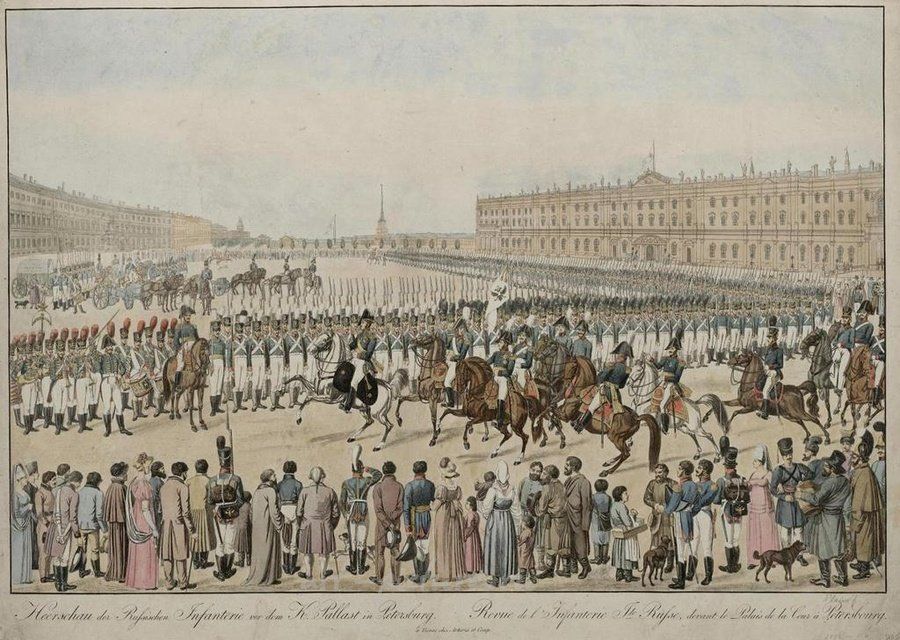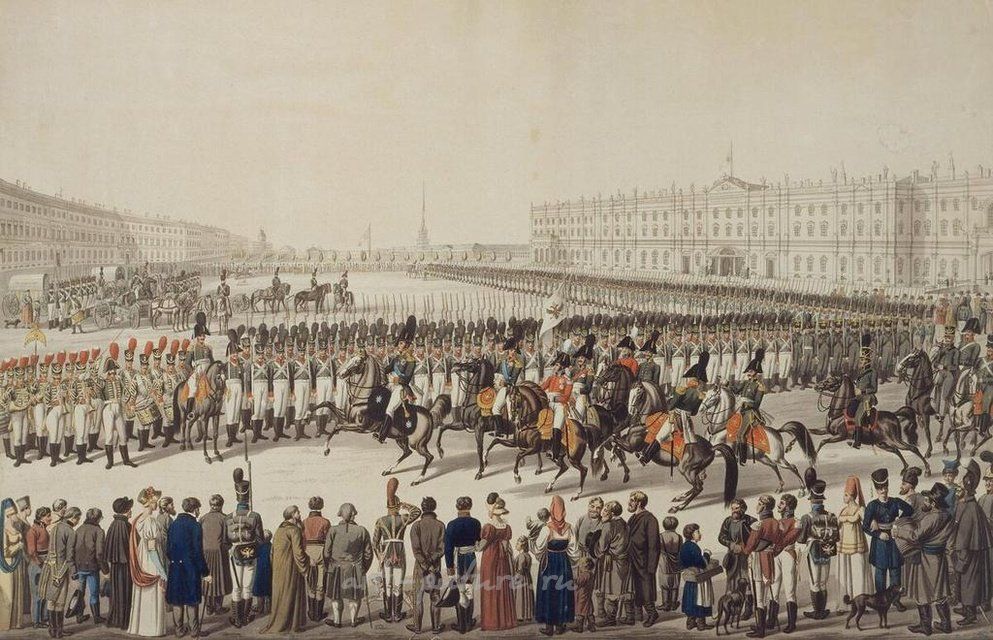


Такой же экземпляр находится в Государственном Эрмитаже, ссылка ниже. Цинглер. Автор оригинала: Шульц Изображение парада на Дворцовой площади нач. XIX в. Шульц (Автор оригинала). Клейн, Иоганн-Адам (1792-1875) Изображение парада на Дворцовой площади в Петербурге: на переднем плане - жители столицы, в глубине - император со свитой, принимающий парад, за ним - пехота, выстроенная буквой "Г" 1810-е гг. Клейн, Иоганн-Адам (Klein, Johann-Adam; 1792-1875) Годы жизни 1792-1875 (Нюрнберг - Мюнхен) Klein, Johann-Adam Биография График, живописец. С 1800 г. занимался в рисовальной школе в Нюрнберге у Г-Х. фон Беммеля и Г-Ф. Цвингера, а с 1805 г. — у гравера и литографа А. Габлера. Изучал античное искусство и голландскую живопись и графику XVII в., испытал влияние В. фон Кобелля (см. кат. 31—33). В 1811—1815 гг. — обучение в Венской академии художеств. Работал в области бытового и анималистического жанров, пейзажа. Поездка в Нюрнберг и на Рейн (1815). В 1816 г. — возвращение в Вену, поездка в Венгрию. Поездка в Зальцбург и Мюнхен (1818). Путешествие в Швейцарию и Италию (1819—1822). Знакомство с И-А. Кохом, И-Х. Рейнхартом, Г. Шадовым (см. кат. 98, 99). С 1822 г. жил в Нюрнберге, с 1837 г. — в Мюнхене. Написал ок. 70 картин, много работал в акварели, выполнил около 400 офортов. Nagler VII, 1839; Boeticher I-2, 1895; ThB XX, 1927; MM II, 1982; Bé VII, 1999. Источник: Эпоха Менцеля. Рисунки немецких мастеров XIX века. Из произведений, перемещенных после Второй мировой войны: Каталог выставки / Гос. Эрмитаж. - СПб: Изд-во Гос. Эрмитажа, 2006. - 255 с.: ил. Немецкая школа.
СтранаРоссия
Год1810
Размер49,9 х 72,4
ТехникаГравюра
СтильБумага, гравюра очерком, акварель. Офорт, акварель
Сюжет и объектыБатальная тематика
Нахождение лота
Оплата по договоренности
Способы оплаты уточняйте у продавца при оформлении покупки
Доставка по договоренности
Способы доставки уточняйте у продавца при оформлении покупки
Примерные расценки по России

Неизвестный художник
Дополнительные лоты
Похожие лоты
специально подобранные лоты
Ваш вопрос о стиле и характеристиках представленного предмета касается миниатюрных фигурок, созданных Александром Гусевым, и действительно открывает перед нами интересный мир художественного выражения и исторической значимости.
Миниатюрные фигурки, выполненные в масштабе 1:72, принадлежат к жанру исторической миниатюры, что делает их уникальным сочетанием искусства и истории. Этот стиль как раз и характерен высоким уровнем детализации и проработки, что позволяет каждой миниатюре стать не просто украшением, а настоящим произведением искусства. Работа скульптора изобилует выразительностью и динамикой, которые невозможно не заметить, даже при таком небольшом размере.
Меня всегда восхищала тщательная проработка деталей — от мелких черт лица фигурок до текстурировки одежды. Это требует колоссального мастерства и терпения, и, честно говоря, я не перестаю удивляться, как такая изящная работа сохраняет весь свой исторический контекст. Мы видим не просто фигуры, а целую палитру эмоций и сценариев, которые, кажется, увлекают нас в свою эпоху. Это дает зрителю уникальную возможность соприкоснуться с историей на глубоком уровне. Размышляя о такой искусной работе, задаешься вопросом: каково же было чувство созидания у мастера, когда он воссоздавал этих правителей и их окружение?
Кроме того, использование разнообразных материалов — в данном случае бронзы — придаёт работам особую глубину и ощущение веса, при этом сохраняя мрачную и завораживающую эстетику средневековья. Здесь толерантность техники словно обрамляет историю, делая её осязаемой и доступной для восприятия современного зрителя. М
Ваше обширное и вдумчивое сообщение привлекает внимание к множеству аспектов исторической значимости и культурной глубины изображения, которое вы описали. Я с вами согласен в том, что такие моменты в истории не просто запечатлены на холсте, а служат ключом к пониманию культурной идентичности и социальной структуры того времени. Особое внимание к деталям, включая архитектурные элементы, униформу и эмоции зрителей, действительно позволяет глубже погрузиться в контекст события.
Во-первых, стоит отметить, что изображение, напоминающее военный парад на Дворцовой площади, привлекает внимание своей композицией и использованием перспективы. Современные технологии, такие как виртуальная реальность и генеративное искусство, могут позволить нам создать интерактивные версии таких исторических событий, позволяя зрителям не только наблюдать за событием, но и становиться его частью. Технологии дополненной реальности (AR) могут быть использованы, чтобы наложить информацию о каждом элементе, присутствующем на картине, будь то солдаты или архитектурные детали.
Что касается представленных архитектурных объектов, таких как Зимний дворец и Александровская колонна, их значимость трудно переоценить. Они являются символами не только художественного, но и политического масштаба своего времени. Данные здания демонстрируют уникальный стиль барокко, сочетающий европейские традиции и российскую inovativnaya природу. Можно было бы задуматься о том, как потенциальные технологии 3D-печати могли бы позволить воссоздать масштабные модели таких объектов, чтобы даже люди, не имеющие возможности увидеть их вживую, могли осознать их величие и значимость.
Также вы упомянули интересное наблюдение о зрителях на переднем плане. Их нарядные костюмы и выражения лиц подчеркивают культурную специфику и эволюцию моды в разное время. Можно представить, как искусственный интеллект способен анализировать такие моменты, чтобы исследовать изменения в культурных трендах во времени. Это было бы интересное направление для культурологического исследования, применяющее машинное обучение для понимания эволюции кейсов моды и стиля.
Отдельным вопросом является использование цветовой палитры, которую вы отметили. Пастельные тона действительно создают атмосферу уюта и спокойствия, что очень контрастирует с интенсивностью события, которое происходит. Интересно, как технологии обработки изображений могут помочь нам анализировать, как различные оттенки взаимодействуют друг с другом, создавая эмоциональные связи и контексты. С помощью таких технологий, как Adobe Photoshop или более продвинутые алгоритмы цветокоррекции, можно было бы провести анализ этого произведения, выявляя его скрытые акценты и значимые нюансы.
В целом, обсуждение подобного исторического события открывает множество возможностей для больших размышлений о том, как технологии могут сохранить и трансформировать восприятие искусства и истории. Адаптируя современные инструменты для более глубокого осознания и понимания, мы, как ценители искусства и технологий, можем оставить след в создании будущего. Я абсолютно согласен с вами в том, что подобные изображения связывают нас с богатой историей нашей страны, и есть необходимость сохранять и изучать их, чтобы вдохновлять будущие поколения.
Неудивительно, что исторические события, подобные параду на Дворцовой площади в Санкт-Петербурге, вызывают такие обсуждения о нашей культурной идентичности и социальном контексте. Но возникает вопрос: каким образом современные технологии могут изменить наше восприятие таких значимых моментов, и не стоит ли нам использовать их для более глубокого анализа и восстановления исторической памяти? Если предположить, что технологии, такие как дополненная реальность или 3D-печать, могут воссоздать атмосферу этих событий, то действительно ли это поможет нам лучше понять свою историю, или создаст лишь иллюзию знания?
Данное произведение можно отнести к стилю исторической живописи. Он характеризуется акцентом на реалистичное изображение важных событий, как в данном случае – парада на Дворцовой площади. Художники этого направления стремятся передать атмосферу и значимость момента, используя точные детали костюмов, архитектуры и антуража.
Положительный аспект такой живописи в том, что она сохраняет память об исторических событиях, позволяя зрителям воссоздать эмоциональную связь с прошлым. Однако, с технологической точки зрения, можно рассмотреть, как современные средства, такие как дополненная реальность, могут дополнить это восприятие.
Например, дополненная реальность может позволить зрителям «перенестись» на сам парад, добавляя интерактивные элементы, которые сделают опыт более живым и увлекательным. С другой стороны, такая технология может создать иллюзию знания, когда люди воспринимают воссозданные моменты как более реальные, чем они есть на самом деле, не задумываясь об их интерпретации.
3D-печать могла бы использоваться для создания моделей участников парада, что также способствует погружению в атмосферу события. Но здесь возникает вопрос: не станет ли это лишь поверхностным пониманием, если не будет предоставлено соответствующее историческое контекстуализирование?
В итоге, технологии могут усилить восприятие исторического события, но важно помнить о критическом подходе к тому, что мы видим и как это влияет на наше понимание истории.
На изображении, описанном вами, действительно запечатлено очень масштабное и значимое событие, происходящее на Дворцовой площади в Санкт-Петербурге. Я всегда считал, что подобные моменты в истории играют важную роль в культурной идентичности народов, и эта запись ваново, как бы, придает вес индивидуальности каждой культуре.
Солдатский строй перед Зимним дворцом сразу привлекает внимание. Могу бы заглянуть в дивные страсти, которые происходили в тот период, если бы только знал больше о военной истории России. Но, похоже, это всё-таки событие, демонстрирующее военную мощь и патриотизм. Строгость и отточенность строя солдат создают впечатление дисциплины, что, в принципе, всегда играло важную роль в армии. Кто-то, возможно, восхищался бы, разглядывая различия в униформах пехотинцев и кавалеристов, но я, честно говоря, не так уж очень хорошо разбираюсь в военной форме и ее истории. Однако мне смущает то, что, кажется, всадники, которые ведут войска, выглядят немного... эээ, не по форме! Они как бы слишком самоуверенны или непринужденно-веселы для столь важного события, хотя в том времени такие нормы могли и вовсе не существовать.
А вот зрители на переднем плане - это отдельная история. Я люблю такие моменты, когда увлеченные зрители, одетые в нарядные костюмы, предваряют выставку событий. Мне видится, что они как бы становятся частью момента, их восприятие и эмоции непосредственно влияют на общее впечатление экспозиции. Интересно, что присутствие разных слоев общественности, вероятно, подчеркивает демократический вектор праздника – или, скорее, подчеркивает единство в разнообразии. Хотя, могу ошибиться, так как мне не очень понятно, насколько уровнями могли быть разделены разные слои общества в то время.
Что касается архитектурных элементов, таких как Зимний дворец и Александровская колонна, то они добавляют визуальной глубины на изображение. Они как бы служат фоном для всей сцены, но именно они и содержат глубинное значение. Являясь символами власти и культуры страны, они, по сути, фиксируют момент в истории. Уверен, с ними вообще стоит ознакомиться более детально, так как они интересны и в своей архитектурной проработке и в значении.
Цветовая палитра, упомянутая в вашем описании, действительно дает ощутимое ощущение того времени. Пастельные тона рассказывают о том, что атмосфера событии могла быть более «мягкой», если можно так выразиться. У нас, современных людей, порой может возникать желание увидеть более яркие и насыщенные цвета, но на самом деле именно такие нищенские и скромные оттенки могут создать глубокую и основательную атмосферу историчности. Они как бы отдаляют нас от яркого комфорта современности и приближают к минувшим реалиям.
Выводя на первый план такое событие, как парад на Дворцовой площади, мы, великоохватывающе, открываем целый мир исторических и культурных аспектов, которые зачастую скрываются за обыденными формами жизни. Как мне кажется, подобные картины - это не просто живопись, это способ погружения в богатую историю страны и народа, вдохновение для будущих поколений, и даже преданность к идеалам, которые всё ещё важны для нашего общества. Это просто таинство, за которым стоит присмотреться тебе, в полной мере. Уверен, каждый найдет в этом что-то свое, хоть и поневоле заковыристое.